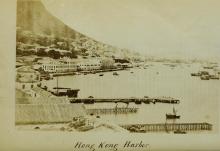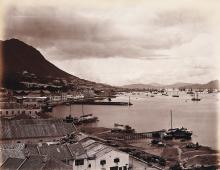
http://www.grs.gov.hk/PRO/imgroot/076%2815%29.jpg
This lot still exists as ML 65, though now subdivided.
[gmap polygon=22.27750506594798,114.16806516050201 + 22.27770610822854,114.16820195316177 + 22.277232045104256,114.16886982320648 + 22.277058304289845,114.1687303483377 + 22.27750506594798,114.16806516050201 |zoom=19 |center=22.27725276990215,114.16847079992294 |width=480px |height=350px |control=Small |type=Map]
Purchased by the Dominican Mission and resumed by Gov for the Praya East reclaimation.
Tenants:
US Navy
US Consulate
Royal Naval Canteen
The Blue buildings were four three-storeyed units built of brick and stone with tile roofs. Behind each unit was a godown.
A sense of history: studies in the social and urban history of Hong Kong
By Carl T. Smith
------------------------------
1878
Mosby, J.S. (the Gray Ghost) U.S. Consulate, Blue Buildings - 2, Praya East
The consulate was on the water'sedge, and after dinner he would sit on the veranda and watch small launches coming and going to ships anchored in the harbour, flying the flags of every trading nation. He felt shut up on the small island, and, when he was lonely and homesick, his gentle side suffered. "I am anxious to see my children who are all that makes life dear to me".
http://books.google.com/books?id=fSz34JfRwy0C&printsec=frontcover&dq=Gr…
1899 - Royal Navy Canteen



Comments
1900s Royal Naval Canteen (Blue Buildings)
re: Blue Buildings
More info from Carl T Smith's Wanchai: In Search of an Identity:
At the corner of Arsenal Street and Praya East [this is before Hennessy Road was built] was the Methodist sponsored Soldiers' and Sailors' Home. Its neighbour in the next building on the Praya was the Royal Navy Canteen which occupied rented premises in the Blue Buildings on Marine Lot 65. The Blue Buildings were four three-storeyed units built of brick and stone with tile roofs. Behind each unit was a godown; for their convenience there was a pier in front. They were built by the Dominican Mission which had purchased ML 65 from George Duddell in 1863. The Blue Buildings were pulled down when Hennessy Road was laid out in the 1920s.
In 1888 a letter appeared in the local press which expressed regret that a valuable opportunity in adding to the attractiveness of Hong Kong was missed in not developing its sea frontage with first-class European residences. It pointed to the Blue Buildings as an example of what should have been done elsewhere.
Re: Blue Buildings
China Mail 11 November 1926
Work on the demolition of the Blue Buildings commenced in November 1926.
Re: Blue Buildings
I've changed the demolition date from 1929-01-01 to 1926-11-1.
Regards, David
The complete demolition of
The complete demolition of the Blue Buildings ended up taking much longer than expected.
Here they are on the seafront, c.1924:
Next is the clipping that Moddsey mentioned above:
It's dated 11 Nov 1926, and says:
The Wesleyan Mision part, including the Sailor's Canteen, is as yet unaffected, but demolition is proceeding of the former Government quarters; and, in time, the whole of the Blue Buildings will be pulled down.
But in this c.1930 photo, the western half of the buildings, the Sailor's Canteen, is still standing:
A photo from 1927 showing the
A photo from 1927 showing the half demolished building:
I've pushed the demolition
I've pushed the demolition date back to c.1930, as though we know the eastern half was demolished in late 1926, the western half is still shown in a c.1930 photo (see comments above). 1930 is still a guess, and the western half may have been demolished even later than that.
Half demolished building
So the reason why the western half of building in the photo here: https://gwulo.com/atom/30378 looks so shabby is probably because the eastern half had been torn down and we are effectively looking at a cross-section of the original building (assuming it is the Blue Buildling) ....and if that's the case, the gap between the Sailors' Home and the remaining (Western) half should be where the rest of the building used to stand? (It's also quite visible in the photo a couple of posts above.) The gap almost doesn't seem big enough for such a large building.
re: Half demolished building
Here's the photo:
There's a lot going on in it.
The full Blue Buildings extended across to about where the gas lamp is, behind the person in the centre of the photo. I've added an outline to the map at the top of the page to show what I think was their full extent.
When the eastern half of the Blue Buildings was demolished, it created a large open space. The north part was to become the new Hennessy Road - that's the triangle of empty land behind the gas lamp. The southern part is where they built the new Methodist Sailors & Soldiers Home, shown in this photo.
It wasn't until late 1938 / early 1939 that Hennessy Road was finally extended past this point to run through to Queen's Road (see comments at https://gwulo.com/atom/22002), but it isn't clear yet if the western half of the Blue Buildings survived that long. More photos of the area from the early-mid 1930s might show when the western half was demolished.
Half-Demolished Blue Buildings
Half-Demolished Blue Buildings
The eastern portion of the Blue Buildings consisting of Government Quarters were demolished in late 1926. China Mail 11 November 1926 refers Tenders were invited for the demolition of part (?) of the Old Naval Canteen and Old Sailors' and Soldiers' Home in mid-1934. HKGRO refers. However, in September 1934, work on the demolition of the Naval Canteen was proceeding but the Government elected to retain part of the old Naval Canteen for use by the Public Works Department as electrical workshops. It appears that the Old Sailors' and Soldiers' Home was also earmarked to disappear. HK Telegraph 12 September 1934 refers
Thanks Moddsey, I've updated
Thanks Moddsey, I've updated the demolition date again, from 1930 to 1934.
1934 Wanchai
A view of the remaining western portion of the Blue Buildings and behind it, the long building with the dark pitched roof straddling Lockhart and Jaffe Roads (which later housed the Hong Kong Bowling Alleys in 1938).
The Naval Canteen in the Blue Buildings
Its opening was reported on page 2 of The China Mail, 1900-09-06:
The New Naval Canteen.
This afternoon Mrs Powell, wife of Commodore Powell, is to open the new Naval Canteen at Blue Buildings. The members of the Navy League have been invited to be present and the ceremony will doubtless be an interesting one. For a long time 'Jack's' club rooms have been unsuited to his requirements, and a movement was set on foot in the beginning of the year to meet his wants. A couple of large buildings on Praya near the Arsenal, which had been used as private boarding houses, were secured, and in a very short period of time, they have been converted into a large and handsome club or 'Canteen,' the accessories of which are certain to attract our sailors when ashore.
The premises consist of two blocks, divided by a long passage. One of the divisions is for the use of the Chief and First Class Petty Officers. On the ground floor there are a commodious bar, a billiard room, dining room, etc., with kitchen and conveniences at the back. Upstairs the caretaker has his private house, while the remainder of the building consists of bed-rooms and reading-rooms with an abundance of light and air. The division set apart for Junior Petty Officers and seamen is much smaller.
Each billiard-room has a piano, and as Jack invariably has 'music in his soul' the pianos it is expected, will not be dummies. At the back of the block a splendid bowling alley is in course of construction. There are also other provisions for the recreation and comfort of the men, too numerous to mention in this short notice. There is every reason to believe that this venture will be a great and lasting success.
Blue Buildings
Blue buildings at 2 Praya East (Marine Lot 65), near the corner of Arsenal Street. Built by the Dominican Mission and used as the US Consulate and later the Royal Naval Canteen. In January 1890 the buildings were purchased by Augustus Sheldon Hooper the first permanent Company Secretary on behalf of Hongkong Land. The property was later surrendered to the Government to make way for the Praya East Reclamation and the construction of Hennessy Road.
Retention of the Naval Canteen Building
No longer the U.S. Consulate…
No longer the U.S. Consulate by September 1882, rented out for private accommodation: